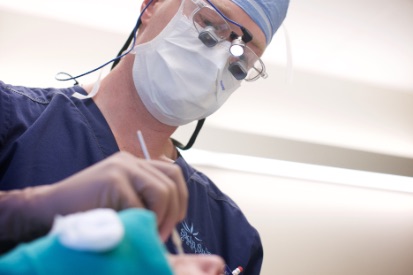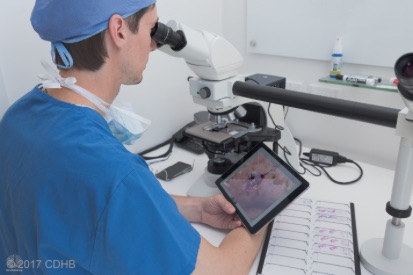Mohs Surgery
The Unmatched Precision of Mohs Surgery for Skin Cancer Treatment
Mohs surgery is widely regarded as the gold standard for treating the two most common forms of skin cancer: squamous cell carcinoma and basal cell carcinoma. This highly specialized procedure, performed under local anesthesia, involves the meticulous, layer-by-layer removal of cancerous tissue. What distinguishes Mohs surgery is its real-time examination of each tissue layer under a microscope after removal, ensuring that the process continues until only healthy, cancer-free tissue remains. This methodical approach guarantees the complete eradication of cancerous cells.
Why Choose Mohs Surgery for Skin Cancer?
Mohs surgery boasts unparalleled effectiveness in dermatologic oncology, with cure rates nearing 99 percent. Its success stems from the precision with which it targets and removes all cancerous cells while preserving as much healthy tissue as possible. Unlike other treatments that may estimate tumor margins visually, Mohs surgery ensures a microscopic examination of the entire surgical margin, significantly lowering the risk of recurrence.
This high degree of accuracy not only offers the highest cure rates but also minimizes the need for additional treatments. Patients who undergo Mohs surgery can take comfort in knowing they have chosen a treatment that offers the best possible outcome for eradicating skin cancer, providing both peace of mind and a superior level of care.
Examples of Mohs Surgery



What is Mohs Surgery?
Mohs surgery is a precise, state-of-the-art procedure for removing skin cancer with the highest potential for cure, even for cancers that have returned. Mohs micrographic surgery allows the physician to examine tissue in real time and ensure all cancer cells are removed while preserving healthy tissue.
This meticulous approach makes Mohs surgery for skin cancer especially effective for basal cell carcinoma, squamous cell carcinoma, and early-stage melanoma. By targeting the entire tumor down to its roots, Mohs surgery maximizes cure rates and minimizes scarring, giving patients confidence and peace of mind.
This procedure is most often used in treating three of the most common forms of skin cancer: melanoma, basal cell carcinoma and squamous cell carcinoma.Mohs Surgery Benefits
Mohs surgery is the most precise method for removing skin cancer, providing patients with confidence in both the effectiveness of the treatment and the preservation of healthy tissue. Performed by specially trained dermatologic surgeons, this technique carefully removes cancer layer by layer while examining each section under a microscope, ensuring thorough treatment and optimal outcomes.
Key benefits of Mohs surgery include:
- Maximized tissue preservation – Healthy skin is spared, reducing scarring and maintaining natural appearance.
- Targeted cancer removal – Every layer is examined to ensure the entire tumor is removed.
- Effective for high-risk areas – Ideal for delicate regions like the face, ears, and hands.
- Lower recurrence rates – Reduces the chance of skin cancer returning compared to other methods.
- Customized reconstructive options – Surgeons can repair the site immediately, improving cosmetic and functional results.
Mohs Surgery at Pinehurst Dermatology & Mohs Surgery Center in North Carolina
Our patient promise is dedicated to your care. Our Mohs surgeons undergo extensive training beyond medical school and residency to ensure you receive comprehensive skin cancer care.
Mohs Surgery: Frequently Asked Questions
By using detailed mapping techniques and complete microscopic control, the Mohs surgeon can pinpoint areas involved with cancer that are otherwise invisible to the naked eye. Therefore, even the smallest microscopic roots of cancer can be removed.
No. Mohs surgery is performed in a pleasant outpatient surgical suite and you may return home the same day.
Yes. Any form of treatment will leave a scar. However, because Mohs surgery removes as little normal tissue as possible, scarring is minimized.
Usually one return visit is all that is needed to examine the healed surgical site or to remove your surgical dressings. Afterwards, you may return to your referring physician for routine check-ups. Lifetime annual check ups are considered essential.
The best protection from skin cancer is to avoid the harmful ultraviolet rays of the sun and wear sunscreen when you spend any time outside - or, in the sun. Even if you tan easily, the sun can contribute to skin cancer in two ways. First, the sunlight damages the genes that control cell growth, and second, sunlight damages the body’s immune system so that early cancers grow unchecked by normal immune defense.
From Our QualDerm Family of Providers: Mohs Surgery for Skin Cancer from Board-Certified Mohs Surgeon Dr. Paula Lapinski
What to Expect at Your During Your Mohs Procedure
During Mohs surgery, your procedure combines precise surgical removal with real-time microscopic analysis. The goal is to remove all cancerous tissue while preserving as much healthy skin as possible.
Here’s what typically happens:
- The visible tumor is carefully removed.
- Your surgeon creates a detailed “map” of the excised tissue to track any remaining cancer cells.
- Each layer of tissue is examined under a microscope.
- If cancer cells are detected, another thin layer is removed only from the affected area, then re-examined.
- This process repeats layer by layer until the tumor is eliminated.
By systematically removing only diseased tissue, Mohs surgery maximizes the chance of complete cancer removal while minimizing impact on surrounding healthy skin. Patients benefit from precision, safety, and the best possible cosmetic and functional outcomes.
How to Prepare for Mohs Surgery
To help ensure a smooth Mohs surgery experience, shower and wash your hair on the day of your procedure and eat your usual breakfast unless instructed otherwise. Bring a list of medications and be ready to complete a brief medical history form.
Upon arrival, complete a medical history form, bringing a list of medications. Discontinue Erectile Dysfunction medication 72 hours before surgery. Avoid alcohol for 48 hours before surgery and follow your provider’s guidance on medications such as aspirin, ibuprofen, or certain supplements. Skip makeup, perfume, nail polish, and jewelry, and arrange transportation if a sedative will be used. Your Mohs surgeon will provide personalized instructions to ensure you are fully prepared.
Planning for Recovery after Mohs Surgery
After Mohs surgery, plan for a smooth recovery by arranging transportation home, as you may feel groggy from anesthesia. Take it easy for a day or two, avoiding strenuous activity, and follow your surgeon’s post-operative care instructions carefully, including keeping the wound clean and dry. Most patients only need a single follow-up visit to examine the surgical site or remove dressings.
Ongoing skin health is important after treatment. Patients who have had skin cancer are at higher risk of developing it again, so lifetime annual skin exams and dermatological checkups are recommended. Your dermatologist will monitor both the treated area and your overall skin to catch any new cancers early.
Featured Products
Check your local office for current stock!
Check your local office for current stock!
